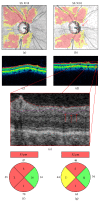Factors Affecting Cirrus-HD OCT Optic Disc Scan Quality: A Review with Case Examples
- PMID: 26351574
- PMCID: PMC4550770
- DOI: 10.1155/2015/746150
Factors Affecting Cirrus-HD OCT Optic Disc Scan Quality: A Review with Case Examples
Abstract
Spectral-domain OCT is an established tool to assist clinicians in detecting glaucoma and monitor disease progression. The widespread use of this imaging modality is due, at least in part, to continuous hardware and software advancements. However, recent evidence indicates that OCT scan artifacts are frequently encountered in clinical practice. Poor image quality invariably challenges the interpretation of test results, with potential implications for the care of glaucoma patients. Therefore, adequate knowledge of various imaging artifacts is necessary. In this work, we describe several factors affecting Cirrus HD-OCT optic disc scan quality and their effects on measurement variability.
Figures










Similar articles
-
Frequency, Type and Cause of Artifacts in Swept-Source and Cirrus HD Optical Coherence Tomography in Cases of Glaucoma and Suspected Glaucoma.Curr Eye Res. 2016 Jul;41(7):957-64. doi: 10.3109/02713683.2015.1075219. Epub 2015 Oct 2. Curr Eye Res. 2016. PMID: 26431251
-
Effect of motion artifacts and scan circle displacements on Cirrus HD-OCT retinal nerve fiber layer thickness measurements.Invest Ophthalmol Vis Sci. 2014 Apr 7;55(4):2251-8. doi: 10.1167/iovs.13-13276. Invest Ophthalmol Vis Sci. 2014. PMID: 24627143
-
Comparison of optic nerve head parameters using Heidelberg Retina Tomograph 3 and spectral-domain optical coherence tomography.Clin Exp Ophthalmol. 2012 Sep-Oct;40(7):721-6. doi: 10.1111/j.1442-9071.2012.02782.x. Epub 2012 May 17. Clin Exp Ophthalmol. 2012. PMID: 22394383
-
[Aiming for zero blindness].Nippon Ganka Gakkai Zasshi. 2015 Mar;119(3):168-93; discussion 194. Nippon Ganka Gakkai Zasshi. 2015. PMID: 25854109 Review. Japanese.
-
[New insights into the study of optic nerve diseases].Nippon Ganka Gakkai Zasshi. 2013 Mar;117(3):187-210; discussion 211. Nippon Ganka Gakkai Zasshi. 2013. PMID: 23631254 Review. Japanese.
Cited by
-
The use of deep learning technology for the detection of optic neuropathy.Quant Imaging Med Surg. 2022 Mar;12(3):2129-2143. doi: 10.21037/qims-21-728. Quant Imaging Med Surg. 2022. PMID: 35284277 Free PMC article. Review.
-
Exploring Publicly Accessible Optical Coherence Tomography Datasets: A Comprehensive Overview.Diagnostics (Basel). 2024 Aug 1;14(15):1668. doi: 10.3390/diagnostics14151668. Diagnostics (Basel). 2024. PMID: 39125544 Free PMC article. Review.
-
An innovative and simple method, clinically comparable to high-definition optical coherence tomography in quantifying posterior segment lesions in the retina.Indian J Ophthalmol. 2020 May;68(5):875-879. doi: 10.4103/ijo.IJO_1188_19. Indian J Ophthalmol. 2020. PMID: 32317469 Free PMC article.
-
Association of retinal neurodegeneration with the progression of cognitive decline in Parkinson's disease.NPJ Parkinsons Dis. 2024 Jan 23;10(1):26. doi: 10.1038/s41531-024-00637-x. NPJ Parkinsons Dis. 2024. PMID: 38263165 Free PMC article.
-
Clinical Utility of Optical Coherence Tomography in Glaucoma.Invest Ophthalmol Vis Sci. 2016 Jul 1;57(9):OCT556-67. doi: 10.1167/iovs.16-19933. Invest Ophthalmol Vis Sci. 2016. PMID: 27537415 Free PMC article. Review.
References
Publication types
LinkOut - more resources
Full Text Sources
Other Literature Sources

